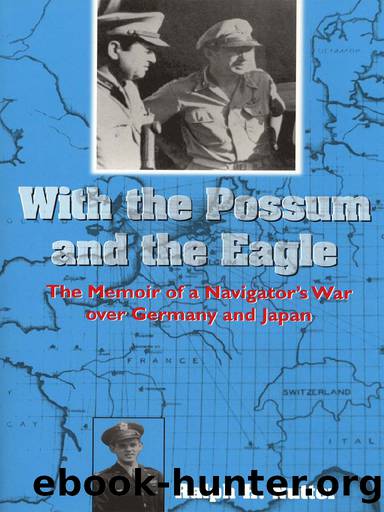With the Possum and the Eagle by Nutter Ralph H.;

Author:Nutter, Ralph H.;
Language: eng
Format: epub
Publisher: University of North Texas Press
Part 2: The Air War Against Japan
14: General Arnoldâs $3 Billion Gamble
The B-29 was designed in 1940 by the Boeing Company as a larger and much improved version of their B-17. Boeing called it the âSuperfortress. It weighed 140,000 pounds and was considered to be the Cadillac of World War II heavy bombers. Its many innovations included pressurized crew areas, improved radar, and a centralized, remotely controlled gun turret system. It could carry seventeen thousand pounds of bombs, almost three times the capacity of the B-17, and its ability to fly much longer distances at higher speeds and altitudes was thought to make it invulnerable to enemy fighters. It was never used against the Germans. Its complex innovations caused substantial production delays, and by the time it became available the air war in Europe was well in hand. The decision was made to send all B-29s to the Pacific, where its great range could be exploited. In its first operations against the Japanese it proved to be a design engineerâs dream and a combat crewâs nightmare.
The first B-29 prototype was flown in September 1942, and Brig. Gen. Kenneth B. Wolfe of the Wright Field Materiel Command supervised its technical development. General Arnold was confident that the air force at last had a heavy bomber that could achieve victory over Japan without the necessity of an invasion. He made extravagant promises to President Roosevelt and the Joint Chiefs of Staff about its capability.
The first production B-29s flew in June 1943 and the plans to use them in combat were developed at the Alliesâ Cairo conference in November. Hansell accompanied Arnold to Cairo. At the conference, Chiang Kai-shek complained to Roosevelt that the Americans had given him inadequate combat support against the Japanese. Chiang said that it was time for the Americans to make a tangible demonstration of their commitment. The president asked Arnold to develop a plan for bombing Japanese targets from China with the B-29. Arnold assigned the task to Hansell, who suggested that B-29s first be based in the vicinity of Calcutta, India. Advanced bases could then be built in the Chengtu area in western China, where they would be within range of targets in Manchuria and southern Japan. There were no land routes from India to China, so it would be necessary to fly all of their supplies over the Himalayas. Routine maintenance would be performed at the bases in India. Hansell recommended this India-China operation as a stopgap measure until air bases were captured closer to Japan.
Arnold doubted the logistical feasibility of basing B-29s in China, but Roosevelt and Churchill overruled him. They believed that even a partial effort would assist the Nationalists in the war against both Japan and Mao Tse-tungâs communists. Churchill said the British would build B-29 bases in India, if Chiang would build the bases in the Chengtu. The president then told Arnold that he expected the B-29s to be available by January 1944. Arnold replied that neither the crews nor the aircraft
Download
This site does not store any files on its server. We only index and link to content provided by other sites. Please contact the content providers to delete copyright contents if any and email us, we'll remove relevant links or contents immediately.
| Afghan & Iraq Wars | American Civil War |
| American Revolution | Vietnam War |
| World War I | World War II |
Waking Up in Heaven: A True Story of Brokenness, Heaven, and Life Again by McVea Crystal & Tresniowski Alex(37031)
Empire of the Sikhs by Patwant Singh(22204)
We're Going to Need More Wine by Gabrielle Union(18105)
Hans Sturm: A Soldier's Odyssey on the Eastern Front by Gordon Williamson(16991)
Leonardo da Vinci by Walter Isaacson(11947)
The Radium Girls by Kate Moore(10940)
Educated by Tara Westover(7093)
Tools of Titans by Timothy Ferriss(6995)
How to Be a Bawse: A Guide to Conquering Life by Lilly Singh(6721)
The Last Black Unicorn by Tiffany Haddish(5091)
Permanent Record by Edward Snowden(5025)
The Rise and Fall of Senator Joe McCarthy by James Cross Giblin(4858)
Promise Me, Dad by Joe Biden(4472)
The Wind in My Hair by Masih Alinejad(4437)
The Crown by Robert Lacey(4125)
A Higher Loyalty: Truth, Lies, and Leadership by James Comey(4052)
The Iron Duke by The Iron Duke(3663)
Joan of Arc by Mary Gordon(3281)
How to be Champion: My Autobiography by Sarah Millican(3202)
